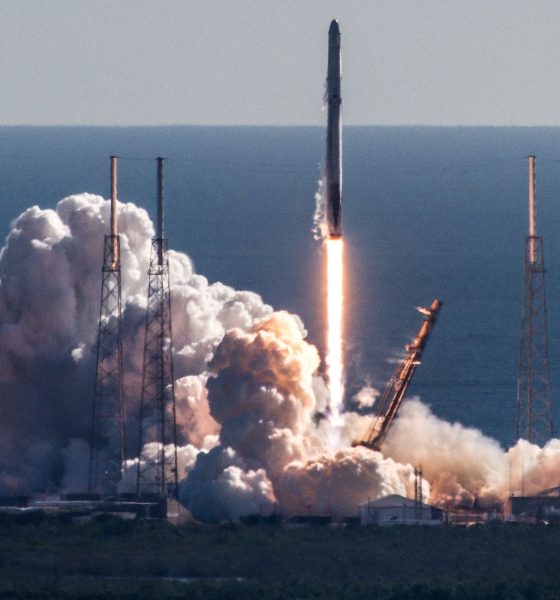

News
SpaceX ready for one more mission before Falcon Heavy’s maiden launch
Set to be the nightcap of relatively slow January for SpaceX, the rocket company is nearing the end of preparations for the launch of a communications satellite co-owned by SES and the government of Luxembourg, known as GovSat-1/SES-16. Scheduled to lift off no earlier than 4:25PM EST (2125 GMT) on Tuesday, January 30, the launch will continue SES’ tradition of flying aboard reused SpaceX rockets, with the ~4000 kg communication satellite expected to be carried into orbit by Falcon 9 B1032 (Booster #32), a booster that first flew during the May 2017 launch of the National Reconnaissance Office’s (NRO) classified NROL-76 spacecraft.

A panorama of LC-40 ahead of its return to flight, the CRS-13 Cargo Dragon mission. The same pad will host GovSat-1 in just over 24 hours. (Tom Cross/Teslarati)
Following an incredible six flight-proven Falcon 9 launches in 2017, the very first year SpaceX began flying reused rockets, GovSat-1 will mark the first of many, many additional flight-proven launches to come in 2018. Even before the inaugural flights of the purpose-built, highly reusable Block 5 of Falcon 9, currently slated for sometime in the next several months, SpaceX is expected to conduct a flurry of flight-proven launches as it wears down its stock of soon-to-be-outdated rockets of the Block 3 and 4 varieties. Educated estimates place the number of reused launches at around five between February and April 2018, six if Falcon Heavy is included (both side boosters are flight-proven). A minimum of six more reused Falcon 9s are then expected to fly between May and the end of 2018, and this almost certainly does not account for the imminent introduction of Block 5.
It is reasonable to assume that the first successful flights of Falcon 9 Block 5 and first several manufactured cores will be followed only months later by a phase change towards reusability. This shift will likely see SpaceX move to a mode of operations that strongly encourages and subsidizes reused boosters as the default option for customers, with flights aboard new cores a comparatively rare alternative reserved only for unique holdouts like NASA, the USAF, and NRO.
2 Falcons on 2 Pads launching by @SpaceX in next 2 weeks 1st time-#FalconHeavy at #pad39A (l) & #Falcon9 #SES16 #GovSat1 at pad #SLC40 (r) post Jan 26 static fire test at @CapeCanaveralFL AFS. Credit: @ken_kremer https://t.co/5g37NsRw85 #SpaceUpClose pic.twitter.com/Lnoh3sCWUB
— Ken Kremer🇺🇦🇩🇪🇺🇸🚀🧪 (@ken_kremer) January 27, 2018
Somewhat sadly, the inherent engineering limits of older versions of Falcon 9 and the imminent introduction of Block 5 mean that SpaceX has less and less of a need to recover flight proven boosters that have no hope of being cost-effectively refurbished and conducting additional flights. This attitude was highlighted with the fourth launch of ten Iridium NEXT satellites in late December 2017, which saw a flight-proven Falcon 9 conduct a controlled ocean ditch after separating from the second stage. While crew aboard at least one of SpaceX’s fleet of recovery vessels were tasked with attempting to recover any accessible floating debris after the first stage ditched into the ocean, it was very much intentionally expended, and SpaceX’s West coast drone ship never left port. GovSat-1 will see this intentional practice of expending recoverable boosters continue – Falcon 9 B1032 is also expected to ditch into the ocean, with no recovery attempt being made aboard the drone ship Of Course I Still Love You.
Nevertheless, SpaceX-leased recovery vessels GO Quest and GO Searcher were both seen leaving Port Canaveral, Florida yesterday, presumably in order to attempt the recovery of either floating debris from the first stage and/or the rocket’s payload fairing, a milestone that SpaceX is still striving to reach.
L-1 day #Falcon9 launch weather forecast. Forecast is unchanged from yesterday. A 40% chance of acceptable conditions in the 2hr launch window tomorrow with the primary concern being winds. #SpaceX #SES #SES16 #GovSat1 pic.twitter.com/PoUx9V0qK7
— Chris G (@ChrisG_SpX) January 29, 2018
Follow along live as launch photographer Tom Cross and I cover these exciting proceedings as close to live as possible. Tom will be heading to Cape Canaveral Air Force Station early tomorrow morning in order to set up his remote cameras to capture yet another beautiful SpaceX launch.
Teslarati – Instagram – Twitter
Tom Cross – Instagram
Eric Ralph – Twitter

News
Tesla FSD fleet is nearing 7 billion total miles, including 2.5 billion city miles
As can be seen on Tesla’s official FSD webpage, vehicles equipped with the system have now navigated over 6.99 billion miles.

Tesla’s Full Self-Driving (Supervised) fleet is closing in on almost 7 billion total miles driven, as per data posted by the company on its official FSD webpage.
These figures hint at the massive scale of data fueling Tesla’s rapid FSD improvements, which have been quite notable as of late.
FSD mileage milestones
As can be seen on Tesla’s official FSD webpage, vehicles equipped with the system have now navigated over 6.99 billion miles. Tesla owner and avid FSD tester Whole Mars Catalog also shared a screenshot indicating that from the nearly 7 billion miles traveled by the FSD fleet, more than 2.5 billion miles were driven inside cities.
City miles are particularly valuable for complex urban scenarios like unprotected turns, pedestrian interactions, and traffic lights. This is also the difference-maker for FSD, as only complex solutions, such as Waymo’s self-driving taxis, operate similarly on inner-city streets. And even then, incidents such as the San Francisco blackouts have proven challenging for sensor-rich vehicles like Waymos.
Tesla’s data edge
Tesla has a number of advantages in the autonomous vehicle sector, one of which is the size of its fleet and the number of vehicles training FSD on real-world roads. Tesla’s nearly 7 billion FSD miles then allow the company to roll out updates that make its vehicles behave like they are being driven by experienced drivers, even if they are operating on their own.
So notable are Tesla’s improvements to FSD that NVIDIA Director of Robotics Jim Fan, after experiencing FSD v14, noted that the system is the first AI that passes what he described as a “Physical Turing Test.”
“Despite knowing exactly how robot learning works, I still find it magical watching the steering wheel turn by itself. First it feels surreal, next it becomes routine. Then, like the smartphone, taking it away actively hurts. This is how humanity gets rewired and glued to god-like technologies,” Fan wrote in a post on X.
News
Tesla starts showing how FSD will change lives in Europe
Local officials tested the system on narrow country roads and were impressed by FSD’s smooth, human-like driving, with some calling the service a game-changer for everyday life in areas that are far from urban centers.

Tesla has launched Europe’s first public shuttle service using Full Self-Driving (Supervised) in the rural Eifelkreis Bitburg-Prüm region of Germany, demonstrating how the technology can restore independence and mobility for people who struggle with limited transport options.
Local officials tested the system on narrow country roads and were impressed by FSD’s smooth, human-like driving, with some calling the service a game-changer for everyday life in areas that are far from urban centers.
Officials see real impact on rural residents
Arzfeld Mayor Johannes Kuhl and District Administrator Andreas Kruppert personally tested the Tesla shuttle service. This allowed them to see just how well FSD navigated winding lanes and rural roads confidently. Kruppert said, “Autonomous driving sounds like science fiction to many, but we simply see here that it works totally well in rural regions too.” Kuhl, for his part, also noted that FSD “feels like a very experienced driver.”
The pilot complements the area’s “Citizen Bus” program, which provides on-demand rides for elderly residents who can no longer drive themselves. Tesla Europe shared a video of a demonstration of the service, highlighting how FSD gives people their freedom back, even in places where public transport is not as prevalent.
What the Ministry for Economic Affairs and Transport says
Rhineland-Palatinate’s Minister Daniela Schmitt supported the project, praising the collaboration that made this “first of its kind in Europe” possible. As per the ministry, the rural rollout for the service shows FSD’s potential beyond major cities, and it delivers tangible benefits like grocery runs, doctor visits, and social connections for isolated residents.
“Reliable and flexible mobility is especially vital in rural areas. With the launch of a shuttle service using self-driving vehicles (FSD supervised) by Tesla in the Eifelkreis Bitburg-Prüm, an innovative pilot project is now getting underway that complements local community bus services. It is the first project of its kind in Europe.
“The result is a real gain for rural mobility: greater accessibility, more flexibility and tangible benefits for everyday life. A strong signal for innovation, cooperation and future-oriented mobility beyond urban centers,” the ministry wrote in a LinkedIn post.
News
Tesla China quietly posts Robotaxi-related job listing
Tesla China is currently seeking a Low Voltage Electrical Engineer to work on circuit board design for the company’s autonomous vehicles.

Tesla has posted a new job listing in Shanghai explicitly tied to its Robotaxi program, fueling speculation that the company is preparing to launch its dedicated autonomous ride-hailing service in China.
As noted in the listing, Tesla China is currently seeking a Low Voltage Electrical Engineer to work on circuit board design for the company’s autonomous vehicles.
Robotaxi-specific role
The listing, which was shared on social media platform X by industry watcher @tslaming, suggested that Tesla China is looking to fill the role urgently. The job listing itself specifically mentions that the person hired for the role will be working on the Low Voltage Hardware team, which would design the circuit boards that would serve as the nervous system of the Robotaxi.
Key tasks for the role, as indicated in the job listing, include collaboration with PCB layout, firmware, mechanical, program management, and validation teams, among other responsibilities. The role is based in Shanghai.
China Robotaxi launch
China represents a massive potential market for robotaxis, with its dense urban centers and supportive policies in select cities. Tesla has limited permission to roll out FSD in the country, though despite this, its vehicles have been hailed as among the best in the market when it comes to autonomous features. So far, at least, it appears that China supports Tesla’s FSD and Robotaxi rollout.
This was hinted at in November, when Tesla brought the Cybercab to the 8th China International Import Expo (CIIE) in Shanghai, marking the first time that the autonomous two-seater was brought to the Asia-Pacific region. The vehicle, despite not having a release date in China, received a significant amount of interest among the event’s attendees.








